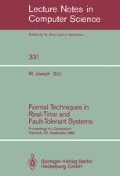Abstract
The introduction of a time component in the data structures used to describe the functional specification of the behaviour of real-time systems produce statements on which time properties may be checked and from which one derive synchronized programs. This paper shows the main features of the specification language as well as the transformation rules into ADA concurrent tasks.
Preview
Unable to display preview. Download preview PDF.
10 References
M. Abadi and Z. Manna. ”A timely resolution.” In Proceedings of the Symposium on Logic in Computer Science, 1986.
J.R. Abrial and S.A. Schuman. ”Non-deterministic system specification.” In Proceedings of the int. conf.on semantics of concurrent computation, Evian, July, 1979.
E.A. Ashcroft and W.W. Wadge. ”LUCID, the data flow programming language.” Academic Press, 1985.
M. R. Barbacci and J. M. Wing. ”Specifying functional and timing behavior for real-time applications.” In Proceedings of the Parallel Architecture and Language Europe, LNCS 258–259, 1987.
G. Berry and L. Cosserat. ”The synchronous programming language ESTEREL and its mathematical semantics.” In Proceedings of the Seminar on Concurrency, Springer-Verlag LNCS 197, 1985.
R.M. Burstall and J. Darlington. A transformation system for developing recursive programs. ACM Journal 24 (1), 1977.
P. Caspi and N. Halbwachs. A functional model for describing and reasoning about time behavior of computing systems. Acta Informatica 22, 595–627, 1986.
P. Caspi, D. Pilaud, N. Halbwachs and J. Plaice. LUSTRE: A declarative language for programming synchronous systems. In Proceedings of the 14th ACM Symposium on Principles of Programming Languages, pages 178–188. ACM January, 1987.
A. Ducrin. Programmation. Bordas, Paris, 1984.
J.P. Finance and J. Jaray. Towards a methodology to specify and construct concurrent programs. CRIN Report 80-P-09, 1980.
A. Gram. Raisonner pour programmer. Dunod, Paris, 1986.
R. E. Griswold and M. T. Griswold. The Icon programming language. Prentice-Hall, Inc., Englewoods Cliffs, New Jersey, 1983.
D. Harel. STATECHARTS: A visual formalism for complex systems. SCP 8(3), June, 1987.
J. Hooman. A compositional proof theory for real-time distributed message passing. In Proceedings of the Parallel Architecture and Language Europe LNCS 259, 1987.
F. Jahanian and A.K. Mok. Safety analysis of timing properties in real-time systems. IEEE Transactions on Software Engineering 12(9) pages 890–904, September, 1986.
C.B. Jones. Systematic program development using VDM. Prentice-Hall. C.A.R. Hoare series. 1984.
J. Julliand, M. Marmonnier and G.R. Perrin. La conception des programmes paralleles dans le project COMETE. Rapport CRIN, 1986.
F. Kröger. Abstract Modules. TUM-I8601 Technische Universitaet Muenchen, January, 1986.
L. Lamport. What good is temporal logic? Information Processing 83. R.E. Masson (ed.) Elsevier Science Publishers, North Holland, 1983
Z. Manna and R. Waldinger. A deductive approach to program synthesis. ACM Transactions on Programming Languages and Systems 6(1), 1984.
R. Milner. A proposal for standard ML. In Conference record of the 1984 ACM conference on Lisp and Functional Programming Austin, Texas, August, 1984.
P. L. Wolper. Temporal logic can be more expressive. In Proceedings of the 22nd Symposium on Foundations of Computer Science, 1981.
P. L. Wolper. Synthesis of communicating processes from temporal logic specifications. Technical report STAN-CS-82-925 Stanford University August, 1982.
Reference Manual for the Ada Programming Language (ANSI/MIL-STD 1815 A) US government, Ada Joint Program Office, January, 1983.
Author information
Authors and Affiliations
Editor information
Rights and permissions
Copyright information
© 1988 Springer-Verlag Berlin Heidelberg
About this paper
Cite this paper
Jaray, J. (1988). Timed specifications for the development of real-time systems. In: Joseph, M. (eds) Formal Techniques in Real-Time and Fault-Tolerant Systems. FTRTFT 1988. Lecture Notes in Computer Science, vol 331. Springer, Berlin, Heidelberg. https://doi.org/10.1007/3-540-50302-1_3
Download citation
DOI: https://doi.org/10.1007/3-540-50302-1_3
Published:
Publisher Name: Springer, Berlin, Heidelberg
Print ISBN: 978-3-540-50302-6
Online ISBN: 978-3-540-45965-1
eBook Packages: Springer Book Archive

